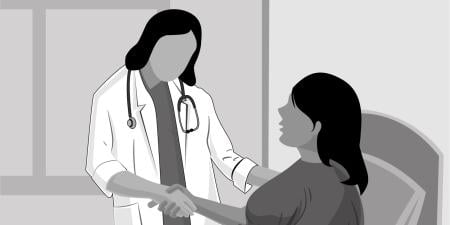The only hope for the future lies in cooperative international action . . . .
To survive in the world we have transformed, we must think in a new way.
John Polanyi, Nobel Laureate in Chemistry (1986)
On February 27, 2002, the Board of Directors of the Bulletin of the Atomic Scientists advanced the "Doomsday Clock" from 9 to 7 minutes before midnight.1 Founded by a group of scientists involved in the Manhattan Project, the Bulletin periodically assesses the geopolitical climate to determine how close humanity is to nuclear Armageddon. Since the clock was established more than a half century ago, this is the third time that the hands have moved forward, towards an unthinkable, self-inflicted extinction of humanity.
While some of the factors considered by the Bulletin arise from the immediate aftermath of the terrorists attacks on the US, many of the global problems that contribute to international instability are fueled by longstanding social and economic disparities between rich and poor nations—abject poverty, poor education, and lack of health care. Given these global challenges, how do we begin to think and act anew, as Polanyi implores, so as to foster international cooperation and collaboration in addressing the root causes of humanity's despair and fanaticism. More specifically, how do we as physicians meet our social obligations and serve as a positive force in addressing the multitude of issues that restrain the flourishing of all peoples.
In thinking and acting anew, physicians are bound in their response by a common heritage of caring for the sick and the suffering. Dating back more than 2½ millennia, the moral foundations of Western medicine have their origins in the Hippocratic Oath, an ethic that is primarily beneficence based. This beneficence model of the "good doctor" has prominently influenced the ethical course of American medicine. Benjamin Rush, a signer of the Declaration of Independence and a founding father of US medical education, championed a moral philosophy of medicine that related virtues and duties to the sound practice of medicine. In forging the world's first national code of professional ethics—the 1847 AMA Code of Ethics—Drs. John Bell and Isaac Hayes were inspired by the Hippocratic tradition to recapture in this national code "a sense of ethical obligation rising superior . . . to considerations of personal advancement".2 For contemporary advocates of virtue ethics such as Edmund Pellegrino and David Thomasma, benevolence and fidelity to trust are as necessary for the practice of good medicine in the present as they were in the past.3
Despite recent theoretical and practical attacks on the Hippocratic ethic,4 I contend that medicine's legitimate status remains centered on an ethic of beneficence and is explicitly reflected in medicine's social contract with humanity. In non-Western medicine, beneficence also serves as a central moral tenet by which physician ethics are formulated and judged. In Islamic medical ethics, for example, greater emphasis is placed on beneficence than on autonomy, especially at the time of death. The saving of a life is considered one of the highest merits and imperatives in Islam. According to the Quran (5:32), " . . . and who so ever gives life to a soul, it shall be as if he had given life to mankind altogether".5 Thus, any intentional efforts to hasten death such as euthanasia are considered murder and are not permissible. In China, the development of medical ethics was greatly influenced by Confucianism. The core of Confucian ethics is benevolence, which means "to wish people well".6 The practice of Chinese medicine is considered a humane art, and a physician must be loving in order to treat the sick and heal the injured. Given the inherent vulnerability created by illness and disease irrespective of color, class, or culture, the exercise of genuine beneficence has endured as an ethical cornerstone of medical practice that binds all physicians over time and across cultures.
The existence of a common ethical paradigm that guides physician obligations and conduct from the East to the Middle East to the West has fostered the concept of a social contract between medicine and society. Generally, social contract theory is the view that ethical conduct is founded on normative agreements that benefit those who make the agreement. In medicine, the social contract has traditionally been defined by the idea that physicians are granted privileges, such as prestige, status, and financial rewards, with the assumption that they will in turn focus on service and altruism.7 However, the social contract is not a legally binding document, nor are the terms of agreement drafted with direct input by both parties. Rather, the social contract is an explicit covenant that imposes obligations and accountabilities on one of the parties to the contract—members of the medical profession.
Enjoying social legitimacy and privilege, physicians have corresponding, inescapable duties to all of society's members. The obligations and duties reflect the 4 "hats" that physicians wear. The first 3 represent physicians in their traditional roles as healer, scientist, and teacher. The fourth, increasingly relevant in today's civil society, is the physician's role as citizen.
Society expects physicians as healers to treat the sick and injured with competence and compassion, and without bias. With increasing diversity of our patient population, physicians must apply their knowledge and skills with objectivity and fairness irrespective of race, religion, nationality, social standing or political affiliation. At the same time, physicians must provide such care when needed, though doing so may put them at risk. The beneficence-based idea that physicians have a duty to treat the sick even though it puts their own lives at risk, is relatively recent. It was not a Hippocratic ideal, and, in fact, physicians who failed to flee epidemics were considered foolhardy. Beginning in the seven-teenth century, ideals of Christian charity combined with notions of gentlemanly honor and noblesse oblige to transform the vice of foolhardiness into a virtue. According to Robert Baker, the first clear statement of a professional duty to treat appears in the 1847 AMA Code of Ethics. It states that "when pestilence prevails it is [physicians' professional duty to the public] to face the danger, and to continue their labors for the alleviation of the suffering, even at the jeopardy of their own lives".8
Society expects physicians as scientists to work freely with colleagues to discover, develop, and promote medical and public health advances that ameliorate suffering and contribute to human flourishing. Sadly, there have been times when physicians have failed to live up to this obligation. In the Tuskegee experiments conducted by US Public Health Service, African American men in the late stages of syphilis were denied treatment with penicillin so that physician-scientists could better understand the course of this disease.9 In Nazi Germany, physicians as agents of the state engaged in unspeakable human experimentation and implemented a sterilization law for persons with a variety of mental and physical disabilities. In response to such heinous acts perpetuated under the guise of biomedical research, the Declaration of Helsinki, which explicitly spelled out human subjects' protections for the ethical conduct of research, was ratified and adopted by medical professional societies across the world in 1964.
Society expects physicians as teachers to train and mentor those who follow them for they are the future of a caring medical profession. Institutions of medical education and training are the beneficiaries of much public support. Because of this, physicians are obligated to act with care and earnestly in the education of students and doctors-in-training. In addition to educating the next generation of healers on their ethical obligations as professionals, society expects physicians to educate the public and polity about present and future threats to the health of humanity. Given great public anxiety and fear raised by new threats of bioterrorism, the profession's duty to provide accurate and relevant information is more important than ever to inoculate against widespread public chaos and panic.
Society expects physicians as citizens to respect human life and the dignity of every individual. Physicians must refrain from supporting or committing acts of prejudice and violence, and condemn any peer who would engage in such acts. Since many factors that influence humanity's health are not medical in nature, physician advocacy for social, economic, and political changes that ameliorate suffering and contribute to human flourishing is essential. As physicians are widely recognized to uphold the ideals of objectivity and compassion, they can reach and assist peoples in need across cultural, religious, and ideological divides. With such access, some have become targets of violence, and to those physicians who labor at the outskirts of human safety and well-being, I salute your courage and dedication. For others who want to help, the AMA is preparing to launch an initiative to care for humanity, and I hope that all of us will respond to this call to action.
Through the centuries, physicians have fulfilled their obligation to care for the sick and the suffering. Today, the medical profession must reaffirm its historical commitment to combat natural and man-made assaults on the health and well being of humanity. Only by acting together across geographic and ideological divides can we overcome such powerful threats. We must act now because time stops for no one.
References
-
Bulletin of the Atomic Scientists. "Doomsday Clock" moves two minutes closer to midnight. http://www.thebulletin.org/content/doomsday-clock/overview. Accessed January 7, 2002.
-
Pellegrino ED. Moral status and relevance of the code. In: Baker RB, Caplan AL, Emanuel LL, Latham SR, eds. The American Medical Ethics Revolution. Baltimore MD: The Johns Hopkins University Press; 1999:317.
-
Pellegrino ED, Thomasma DC. The Virtues in Medical Practice. New York: Oxford University Press; 1993.
-
Veatch RM. Who should control the scope and nature of medical ethics? In: Baker RB, Caplan AL, Emanuel LL, Latham SR, eds. The American Medical Ethics Revolution. Baltimore MD: The Johns Hopkins University Press; 1999:158-191.
-
Shakir M, trans. The Quran. Elmhurst, NY: tahrik-e tarsil-e Quran; 1993.
- Zhaojiang G. Chinese Confucian culture and the medical ethical tradition. J Med Ethics. 1995;21(239):246-
- Cruess RL, Cruess SR, Johnston SE. Professionalism and medicine's social contract. J Bone Joint Surg. 2000;82(8):1189-1194.
-
American Medical Association. Code of Ethics (1847). In: Baker RB, Caplan AL, Emanuel LL, Latham SR, eds. The American Medical Ethics Revolution. Baltimore, MD: The Johns Hopkins University Press; 1999:333.
- Corbie-Smith G. The continuing legacy of the Tuskegee Syphilis Study: considerations for clinical investigation. Am J Med Sci. 1999;317(1):5-8.



